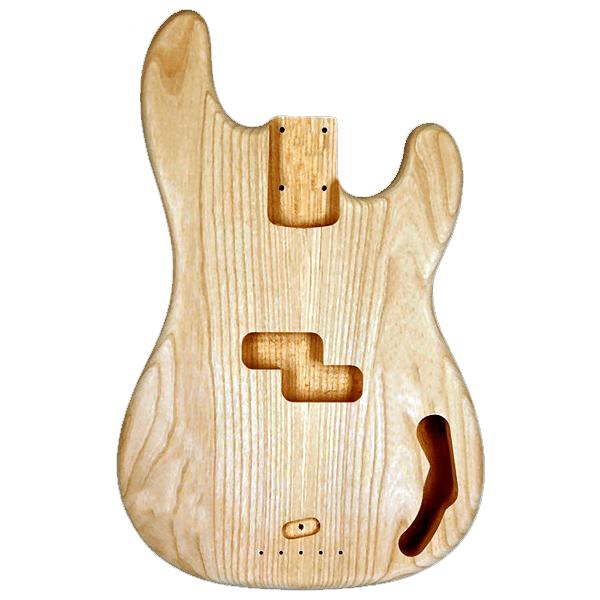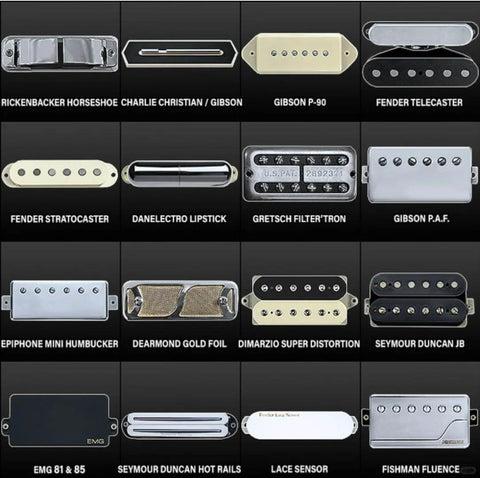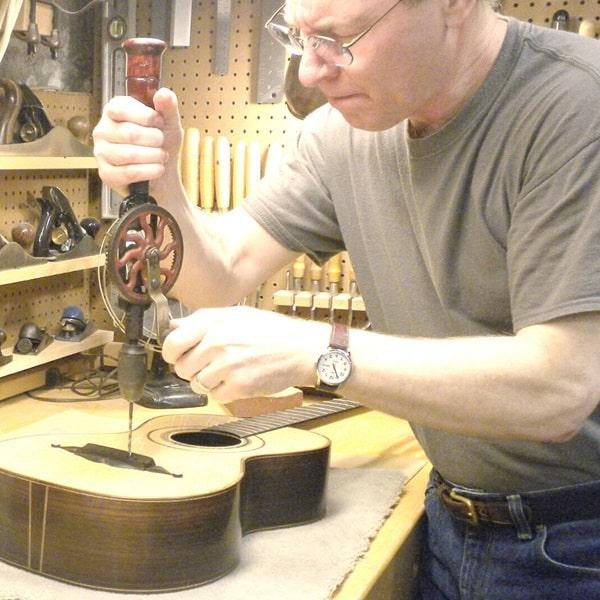There I was, standing in my workshop surrounded by wood, wires, and dreams of creating a sound that would resonate through the souls of many. At that moment, a profound realization struck me: truly understanding a bass guitar’s anatomy is like unlocking a secret language of music. Every curve, every tiny component holds the promise of the perfect sound—if only you know how to bring them together. Just as R.M. Mottola’s transition from engineering to lutherie forged a deep connection between design precision and musical artistry, my journey led me to explore the intricate world of bass guitar anatomy. Did you know that the seemingly simple act of adjusting a bridge can transform the entire character of a bass guitar? It’s these hidden nuances that we’ll explore, diving into the crucial roles of the body, neck, pickups, and more. Prepare to embark on an enlightening journey into the heart of a bass guitar.
What are the Main Parts of a Bass Guitar?
The Body

Did you know that the shape and material of the bass body can drastically affect its tonal character? With years of experience in instrument acoustics, I’ve seen firsthand how crucial this component is in defining a bass guitar’s sound. The bass body is not just a piece of wood; it is the heart of the instrument’s resonance and sustain. The design intricacies—from the choice of tonewoods such as alder or mahogany to the contours of the body itself—play a significant role in shaping the sonic qualities of the guitar. Sleek contours and solid construction enhance playability while minimizing vibration loss, thereby enriching the resonance. Experts like R.M. Mottola emphasize that the body’s design can enhance resonance and produce desirable sound qualities. As you delve further into understanding these elements, remember that the bass body is essential not only for its aesthetic value but also for its profound impact on sound production.
The Neck

As someone deeply immersed in the craftsmanship of musical instruments, I often get asked, what makes the neck of a bass guitar so crucial for comfortable playability? The *bass neck* is undeniably central to both the instrument’s playability and the musician’s experience. A well-constructed neck not only affects the *tone* but also the ease with which one can express their *artistry*. The neck connects the body with the headstock, housing the fingerboard where the musician’s hands do most of their work.
R.M. Mottola’s expertise reveals how *neck construction* determines the action, or the distance between strings and fretboard, which is pivotal for ensuring ease of play. A smooth, properly adjusted neck allows for seamless transitions across notes, reducing strain and enhancing musical fluidity. Understanding these nuances ensures that musicians achieve the most comfortable and inspiring experience possible—a crucial factor that molds both the sound and soul of the instrument.
Pickups

Ever wondered how the type of pickups you choose can redefine the sound of your bass guitar? As I delve into the world of bass pickups, I realize how crucial they are in capturing the soul of your instrument’s sound. Bass pickups act as the heart of the guitar’s tonal landscape, converting string vibrations into signals that are sent to the amplifier. An understanding of their functionality enlightens us on how a bass guitar articulates its distinctive voice.
Different pickup designs offer a unique canvas on which your musical expression is painted. From the rich warmth of passive pickups, which offer an organic and natural tone, to the dynamic and powerful presence of their active counterparts, which provide enhanced sound control and clarity—each type holds its own allure. My extensive exploration with various pickups has shown that their placement and configuration significantly shape the bass’s character and tonal depth.
R.M. Mottola shares insights on how different pickup designs can capture subtleties in tone, highlighting the importance of this component in sound production. Appreciating this aspect allows us to not only choose pickups that align with our sonic goals but also modify sound outputs effectively, emphasizing just how integral pickups are to the bass guitar’s anatomy and its influence on performance.
Bridge

Could the right bridge configuration be the key to unlocking your bass guitar’s full potential? From personal experience, I’ve found the bass bridge to be an essential component that often goes unnoticed amidst the more glamorous pickups and finishes. Having worked with numerous bridge styles, I can tell you that the bridge not only supports the strings but also has a profound impact on intonation and sustain. The choice of material, design, and even adjustments made to the bridge can significantly affect how your bass resonates and projects sound.
A well-crafted bridge serves as the anchor point where sonic energy from the strings is transmitted to the body and neck of the instrument, influencing the overall tone and playability. This part of the bass essentially dictates how your instrument interacts with your playing style and the nuances of your musical expressions.
Understanding and choosing the right bridge is crucial for tailoring your bass guitar to your sonic preferences and ensuring a harmonious blend with your ensemble. Continue reading as we explore the bridge’s intricacies and guide you on maintaining your bass guitar for optimal performance.
Electronic Controls

Electronic controls are pivotal in enhancing the *versatility* of a bass guitar. As someone who has delved deeply into the world of electronic components, I can attest to how crucial these controls are in *shaping a musician’s sound* and expanding their creative palette. They allow players to *sculpt and tweak* their tone, offering a wide array of sound possibilities that can transform a simple rhythm section into a dynamic force.
How do the electronic controls enhance the versatility of a bass guitar? These controls, which typically include volume and tone knobs, contribute significantly to an instrument’s adaptability. Adjusting the **tone controls** can make the bass sound warmer or brighter, while the **volume controls** help in balancing the output with other instruments. This integration not only affects the sound but also influences the overall playing experience by providing musicians the tools to express their musical identity more distinctly.
Transitioning smoothly from hardware to sound customization, the role of these controls in the broader composition of a bass guitar’s parts cannot be overstated. They seamlessly intertwine with the pickups and bridge, creating a holistic tonal architecture that corresponds with *each player’s unique style*. Understanding these components and mastering their use is a gateway to unlocking the full potential of your instrument.
Why are the Parts Important?
Role of the Body in Sound Production

Could the body of your bass guitar be the unsung hero in its sound production? As I delve deeper into the intricate world of *bass guitar parts*, I find that the body holds a unique influence over the instrument’s tonal prowess. Often overshadowed by more visible components like the neck or pickups, the body plays a crucial role in shaping sound. According to R.M. Mottola, the body does much more than provide a foundation; it acts as a **resonant chamber** that significantly influences the tonal qualities of your bass.
This resonance contributes to the overall *sound profile* of the instrument. Mastering how these vibrations interact reminds me that the **importance of each bass guitar part** extends beyond the superficial—a connection felt when the bass produces a rich, full sound that reverberates through a performance. Capturing this comes down to the intricacies of the body’s design. Thus, as we strive to understand why the parts are important, acknowledging the body’s role in sound production is paramount.
As we transition from understanding the body’s significance, we’ll explore the impact of the neck on playability next. Understanding how each component harmonizes helps appreciate the bass’s sophistication.
Neck and Playability

The neck is the heart of a bass guitar’s playability, directly impacting how easily you can express your musical ideas. As a bass player, I’ve learned that its design aspects such as angle, width, and profile are crucial in ensuring comfort and ease when navigating the fretboard. So, what factors about the neck determine how easily you can navigate the fretboard? Let’s explore this further.
R.M. Mottola explains that the bass guitar setup—essentially how the neck is adjusted—plays a critical role in shaping both the player’s experience and performance capabilities. For instance, the neck’s angle affects string tension and action, key elements in executing smooth and fluid play. The width and profile determine how your hand moves along the fretboard, directly impacting your ability to perform complex musical passages. Having the right setup allows for precise finger positioning, facilitating advanced techniques and reducing hand fatigue.
Understanding the interplay between the neck’s physical properties and its influence on your playing enhances your ability to tailor the bass guitar to your personal style, making this knowledge invaluable within the context of why each part is important.
Impact of Pickups on Tone

Is it possible that the pickup type could turn your bass into a completely different instrument? This idea might sound radical, but it’s grounded in reality. The pickups on a bass guitar are more than just *functional components*; they are critical contributors to the instrument’s **character and identity**. In exploring the *types of bass guitars*, we see that pickups play a pivotal role in defining their sound. My deep dive into this revealed the profound impact different pickup configurations have on tone, enabling bassists to traverse *unique soundscapes* and craft sounds that suit a plethora of genres. R.M. Mottola highlights how these tiny yet powerful components are integral in shaping not only the *sonic qualities* but also the overall performance style of a player. Understanding pickups is crucial not just for recognizing why parts matter, but also for elevating one’s artistic expression and playability on the bass guitar.
How to Maintain Your Bass Guitar Parts
Cleaning the Body

Maintaining your bass guitar’s body is crucial not only for its aesthetic appeal but also for its sound quality. The body serves as a resonating chamber influencing the tone and response, so proper care is essential. What are the most effective cleaning techniques to keep your bass guitar looking and sounding great? Based on my experiences, I find that regular cleaning prevents grime buildup, which can dampen reverberations and impact resonance.
A consistent cleaning routine involves a soft, lint-free cloth to gently wipe down the body after each use. This simple act removes oils and dust, preserving the wood’s natural sheen and vibrancy. A slightly damp cloth with a diluted vinegar solution can be used sparingly to tackle stubborn spots, ensuring the finish isn’t compromised. Applying a high-quality polish periodically enhances the body by adding a protective layer, promoting its durability and the integrity of its bass guitar assembly.
R.M. Mottola’s insights reveal that these methods not only maintain your instrument’s appearance but also safeguard its tonal properties. By focusing on the intersection of aesthetics and acoustics, I ensure my bass not only looks pristine but performs at its best, reinforcing the guitar’s vital role in both my music and maintenance practices.
Neck Care

Are you risking your instrument’s playability with neglectful neck maintenance? The neck, a crucial component of your bass guitar, directly influences comfort and sound quality. Without proper care, the neck’s integrity may diminish, leading to significant *playability* issues. Based on my *years of experience*, consistent neck maintenance is vital, a sentiment strongly echoed by R.M. Mottola’s insights. Regularly adjusting the neck relief and checking for fret wear are not just recommended practices; they are *essential* to ensuring your bass stays in peak condition. Neglect could result in costly repairs or, worse, an *unplayable instrument*.
Attention to guitar components like the neck doesn’t just preserve your bass; it enhances your playing experience. Simple habits such as using the truss rod to fine-tune neck relief can vastly improve playability and prolong the instrument’s life. As you delve deeper into maintaining your bass *effectively*, consider the neck’s pivotal role—arm yourself with the knowledge to keep it in top form.
Managing Electronics

Does your understanding of electronics impact your ability to troubleshoot common issues? Absolutely, and this insight often distinguishes seasoned bassists from novices. Drawing from my experiences in both music theory for bass and instrument care, I’ve found that knowing your bass guitar’s electronics is crucial for *optimizing performance* and ensuring its longevity.
Electronic controls in a bass guitar define your tonal range, and a well-maintained circuit extends the life of your instrument. *Regular maintenance* involves more than simply ensuring connections are secure; it means having a hands-on understanding of circuits, wires, and components—skills that can save both time and costly repairs. For instance, inspecting for loose solder joints or cleaning potentiometers are small tasks that can significantly *enhance sound clarity*.
R.M. Mottola emphasizes the value of familiarizing oneself with these controls as it not only boosts *your ability to tailor your sound* but also heightens your overall connection with the instrument. So, dive into the details of your bass’s electronics; it’s as crucial as mastering its strings.
Conclusion
Have you gained a comprehensive understanding of the parts that make your bass guitar unique? Through exploring the *bass guitar anatomy*, we’ve traversed from the sculpted body to the intricate neck, down to the critical electronics and pickups, each component a *key player* in producing distinctive sounds. Each part interconnects seamlessly, shaping not only the music but the journey of every player, as R.M. Mottola observes.
Recognizing the melody produced by the combination of body resonance and neck playability enhances your appreciation for why these parts matter. For the aspiring bassist, understanding the *role of the body in sound production* or the *impact of pickups on tone* transforms the instrument from mere wood and wire into a powerful tool for creativity.
These insights allow you to approach maintenance—cleaning, neck care, managing electronics—with a newfound knowledge and respect, ensuring your bass remains an extension of your musical expression for years to come.
FAQs

R.M. Mottola, an engineer-turned-luthier, revolutionizes stringed instrument design with his deep focus on acoustics and ergonomics since 1994. As editor of the Savart Journal and a key contributor to American Lutherie, Mottola merges science with artistry in lutherie. He enriches the field with his extensive knowledge, shared through his Liutaio Mottola website, making him a beacon in the world of modern instrument craftsmanship.
